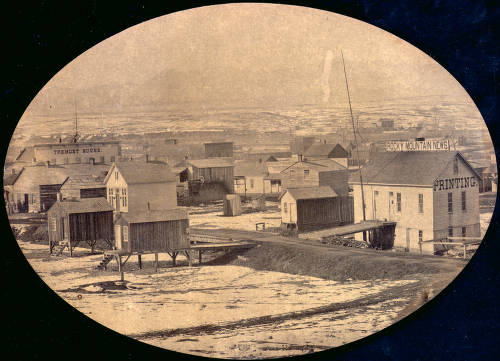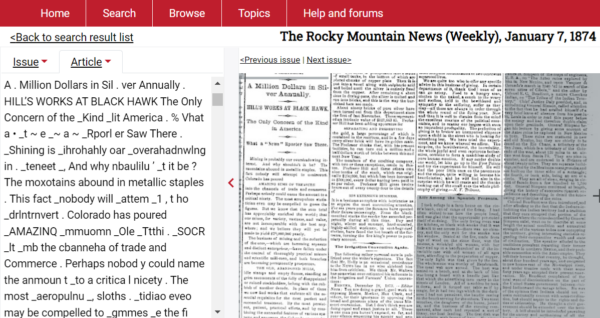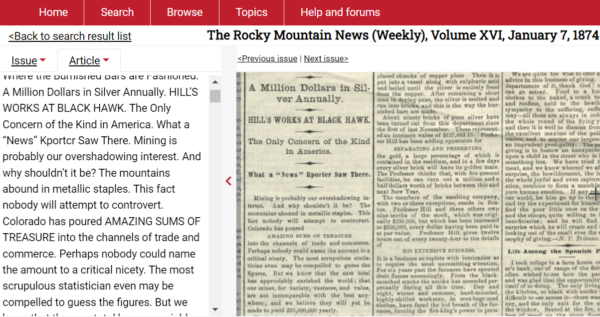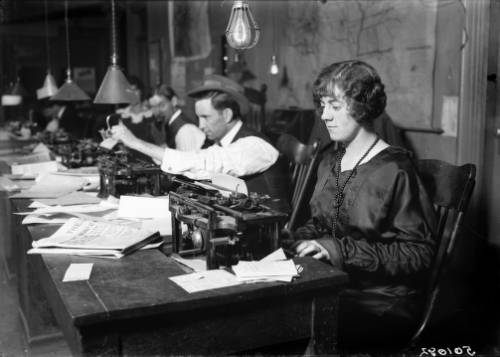The Rocky Mountain News (RMN) was Colorado’s oldest newspaper. Founded by William Byers during the 1859 Colorado Gold Rush, the paper closed its doors in 2009, just two months before its 150th anniversary. Shortly after closing, Scripps Howard finalized an agreement that would transfer the Rocky’s voluminous archives, photo morgue, and copyright to the Denver Public Library (DPL),
to ensure responsible stewardship of the storied newspaper’s archives and artifacts.
It has long been the goal of DPL and the Colorado Historic Newspapers Collection (CHNC) to make access to RMN freely available. We can now begin to achieve this goal with the support of a generous bequest from former DPL librarian Hank Shearouse. With this support DPL and CHNC will begin the long term goal of digitizing the entire run of RMN, starting with RMN Weekly’s April 1859 launch and RMN Daily’s August 1860 launch through, it’s estimated, the turn of the 20th century.

Important Source of Historic News
For its entire run, RMN was an important source of information throughout Colorado and the surrounding territories. The early issues of RMN cover some of the most important aspects of not only Western history, but American history as a whole: westward expansion and the beginnings of Denver and Colorado statehood, the mining boom and bust era, conflicts with Native American tribes including the Sand Creek Massacre, the building of the Union Pacific railroad and the rise of anti-Chinese sentiment in the US, the passage of women’s suffrage in Colorado by popular vote that paved the way for the 19th Amendment, political corruption and the rise of the Ku Klux Klan in the US West, the Ludlow Massacre—a term coined by the RMN—and the fight for worker’s rights —and so much more.
RMN’s distinctly Coloradan point of view provides key insights into these events and their impact on the American West which often differed from other parts of the US. Aside from the boundless benefits for teachers, historians, and general researchers, RMN’s coverage of social, political, and cultural happenings has lasting significance for political science, public policy, sociology, and many other social science disciplines. Making RMN accessible in CHNC means unearthing tremendous amounts of source material providing vital insight into the changing attitudes of the day, with the potential to significantly impact many diverse fields of inquiry.
Improved Access
Some may ask, isn’t RMN already online? In fact most of RMN has not been digitized and very little is currently freely accessible online. At present, only a limited selection of RMN’s 150 years in print is available online, and mostly on a subscription basis (NewsBank), making it outside the reach of most libraries and therefore the public at large. The full run of RMN is only available through microfilm at a limited number of institutions. As some of you may know, a small portion of RMN, digitized from the existing microfilm, has been available in CHNC—the Weekly RMN from April 23, 1859 to December 27, 1876 and RMN Daily from August 27, 1860 to October 3, 1875 and a few issues from 1912. The quality of existing microfilm of RMN, as well as the existing CHNC RMN content, was assessed in 2019 and it was determined that the original filming was done poorly and often from originals in poor condition. When film of poor quality is digitized, it results in numerous OCR (text recognition) inaccuracies which results in little to no search results.
How can we be so sure? Well we tested it! The results were clear. Digitizing the originals greatly improves the OCR text.


To that end, we will digitize DPL’s original RMN newspapers. We will also digitize, from original, RMN issues that are already in CHNC. This will improve the quality of the page images and the resulting OCR, ensuring more successful search results for CHNC users. It is rare for such a vast and complete run of original newspapers to remain in existence after microfilming. We are grateful that this important resource has been preserved by DPL.
CHNC vs Paid Subscription Services
Although only a small portion is freely available in CHNC, RMN is consistently one of the top ten most searched CHNC titles. CHNC’s online platform is freely accessible to anyone with an internet connection anywhere in the world. CHNC averages 18,000 users a month, with 75% of users outside of Colorado, meaning its resources are largely being used and discovered by those outside of the Mountain West. The intuitive layout of the website, the ability to “clip,” print, and save articles, and the use of searchable OCR text recognition make for accessible research with ease. Users can optionally register with the site and contribute to the value of the collection by correcting text that was misread, or not read at all, by the automated OCR. The text will also be machine-read from the images and fully indexable by search engines such as Google and Bing.
RMN will also be searchable in Elephind. Elephind aggregates international newspaper collections, including all CHNC titles, making them searchable in one place. In late 2020, CHNC in partnership with Wyoming State Library and University of Wyoming, developed a shared Colorado-Wyoming historic newspapers site, the Plains to Peaks Historic Newspapers, built on the same platform as CHNC. Aggregating this content will allow scholars to easily compare and contrast diverse viewpoints on subjects and events reported on over time. Providing RMN through the digital, easy-to-use, open-access CHNC platform will ensure it reaches the widest possible audience and freeing RMN from access barriers – which can’t be achieved by the for-profit newspaper sites.
Sustainability Through Collaboration

We are not the only ones that feel this way. Other institutions are partnering with us to ensure the full scope of this project is realized. Most recently, this project was kicked off with support from the Salida Regional Library who added to CHNC the RMN (Weekly) 1879 to 1880. These years are an important source of information detailing the development and growth of Salida.
This project provides an excellent opportunity for Coloradans to join forces in uncovering this jewel of American journalism. If you would like information on how you can support this project please contact me, Leigh Jeremias, at ljeremias@coloradovirtuallibrary.org or donate to the project directly here. Thank you for helping us Free the Rocky (#FreeTheRocky)!
- It Takes a Village: New News for Weld and Pitkin Counties - June 26, 2025
- Socialism and a Denver Suburb: New Additions to CHNC - June 6, 2025
- 2025 Support for Newspaper Digitization - November 13, 2024